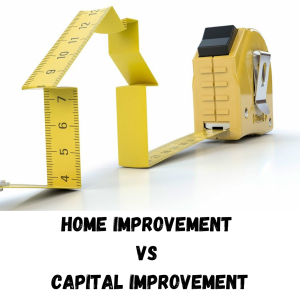
The distinction between regular home improvement and capital improvements is important for homeowners to understand, especially for financial planning, tax purposes, and property value
assessment. Here’s an explanation of each term and their differences:
Regular Home Improvement
Regular home improvements are repairs or upgrades that maintain or enhance the current condition and functionality of a home. These improvements are typically more routine and do not significantly increase the property’s value or extend its useful life.
Examples of Home Improvement
- Painting the interior or exterior of the house
- Replacing worn-out flooring
- Fixing or replacing a broken window
- Updating light fixtures
- Repairing a leaky roof
Characteristics of Home Improvement
- Often considered maintenance or upkeep
- Typically smaller in scale and cost
- Usually do not add substantial value to the home
- May not be tax-deductible (depending on the specific situation and tax laws)
Capital Improvements
Capital improvements are substantial upgrades or additions that enhance the value of the property, extend its useful life, or adapt it to new uses. These improvements are usually larger in scope and more costly than regular home improvements.
Examples of Capital Improvements
- Adding a new room or extension to the house
- Installing a new roof
- Building a garage or carport
- Upgrading the HVAC system
- Modernizing the kitchen or bathroom with new appliances, countertops, and fixtures
- Installing energy-efficient windows or solar panels
Characteristics
- Increase the overall value of the property
- Extend the life of the property or its components
- Adapt the property to new uses
- Often considered investments in the property
- May be tax-deductible as they can be added to the property’s cost basis, potentially reducing capital gains tax when the property is sold
Tax Implications
Regular Home Improvements
These costs are generally not tax-deductible. However, if you make home improvements for medical reasons (such as adding wheelchair ramps), you might be able to deduct some or all of the cost as a medical expense.
Capital Improvements
These can increase the property’s cost basis, which can reduce the amount of capital gains tax you owe when you sell your home. It’s important to keep detailed records and receipts of all capital improvements.
Key Differences
Scope and Cost
Capital improvements are usually larger in scope and cost compared to regular home improvements.
Value Addition
Capital improvements add significant value to the property, whereas regular home improvements primarily maintain its current state.
Tax Treatment
Capital improvements can be added to the cost basis of the property for tax purposes, while regular home improvements usually cannot.
Understanding these differences can help homeowners make informed decisions about where to invest their money and how to manage their finances, especially when planning for potential property sales or tax considerations.
